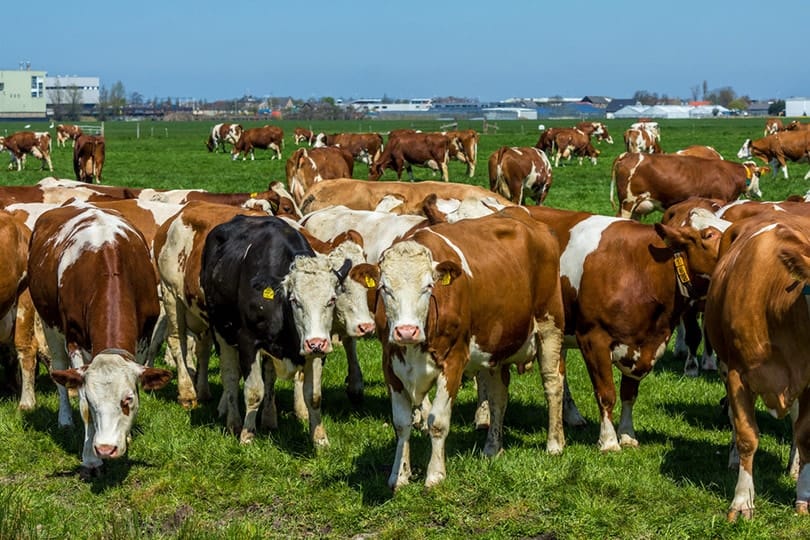The Hays Converter Cattle was the first breed recognized by the Canadian Livestock Pedigree Act. It was developed by Senator Harry Hays of Alberta, Canada, who was also a dairy farmer and livestock auctioneer. Hays was unhappy with cattle breeders who were more concerned with the animals’ appearance than performance. In the 1950s, he began crossbreeding different cattle with traits he believed would improve the cattle industry in Canada. He wanted a cow that developed quickly and reached market weight in approximately 12 months. Although the Hays breeding program was successful, the breed was not effectively promoted, and cattle ranchers eventually chose European breeds imported in the 1960s.
 Quick Facts about Hays Converter
Quick Facts about Hays Converter
| Breed Name: | Hays Converter Cattle |
| Place of Origin: | Canada |
| Uses: | Beef |
| Bull (Male) Size: | 1,043-1,270 kilograms |
| Cow (Female) Size: | 567-680 kilograms |
| Color: | Black with white sections |
| Lifespan: | 10-12 years |
| Climate Tolerance: | adapted to cold climates |
| Care Level: | Minimal |
| Production: | Lean beef |
| Milk production: | High |
Hays Converter Origins
Harry Hays experimented with different breed combinations in the 1950s to develop the Hays Converter. Ultimately, he chose the Holstein, Hereford, and Brown Swiss cattle to produce the desired characteristics needed for the climate of Western Canada. In 1975, the Hays Converter was recognized by the Canadian beef industry as the first pedigree breed in Canada. Although the cattle developed quickly and produced lean beef, the breed failed to proliferate after more desirable European cattle were imported in the 1960s. Hereford cattle are used more than any other breed for beef in Canada, and most herds are located in the country’s western regions.
Hays Converter Characteristics
Hays Converter cattle are hornless animals that are black with white legs, heads, and underbellies. In rarer instances, some cows are red and white. They are a large breed with cows weighing up to 680 kilograms and bulls weighing up to 1,270 kilograms. Harry Hays was most concerned with creating cattle that could mature quickly and produce milk with a high butterfat content. He used the term “converter” in the name of his cattle to promote the animal’s ability to convert smaller quantities of feed into premium beef.
He used the Hereford for its fast maturity rate and impressive carcass characteristics and the Holstein for its high milk production. As a dairy farmer, Hays was concerned that breeders were not prioritizing healthy utters in their programs, and he noticed that most cows were producing milk only at the beginning of the lactation period. Hays understood that calves develop quicker when their mothers produce more milk, and he added the Brown Swiss cattle to give his Converter cattle utters capable of producing milk up to the end of lactation.
The cold, dry landscape of Alberta is not suitable for every cattle breed, but the Hays Converter has strong legs for grazing in wild pastures, and unlike other cattle, the Hays cows do not lose their appetite when the temperature drops below freezing.
Uses
As a minister of agriculture, Hays helped develop the plan that allowed European Cattle to be safely imported into Canada. Unfortunately, the arrival of the new breeds made Hays’ cattle less desirable to cattle ranchers. Today, Hays Converter herds are maintained in Alberta for beef and breeding studies. Compared to older species with more complex histories, Converter cattle can be traced back to the original breeding participants. The University of Alberta currently manages the offspring of Hays’ original herds and uses the animals for genomic research that can improve the breeding and selection process of Canadian cattle.
Appearance & Varieties
Hays Converters are leaner cows with a rougher appearance compared to the Holstein or Hereford. Their coats are not smooth and attractive like British cattle, and this difference caused some ranchers to favor the newer European breeds that entered the market while the Hays Converter breed was being developed. Harry Hays was not concerned about how his cattle looked, but he succeeded in producing Converter yearlings (one-year-old calves) that weighed an average of 500 kilograms. Converter calves mature faster than competing breeds and can quickly enter the beef market. Records from 2006 to 2010 indicate the Hays Converter yearlings still maintained an average weight that exceeded 500 kilograms.
The cattle’s durable hoofs and strong legs are adapted to the harsh winters of Western Canada. Unlike other cattle, Converters do not need their hoofs trimmed. They graze on wild grasses, but in harsher conditions, they’re given commercial feed.
Population/Distribution/Habitat
After the Hays ranch was sold in 2000, the University of Alberta moved the cattle to a special breeding facility in High River, Alberta. Although a few small herds are maintained in Western Canada, the number of Hays breeding cows declined in the 21st century. As of 2016, only 130 breeders lived at the High River facility.
 Are Hays Converter Cattle Good for Small-Scale Farming?
Are Hays Converter Cattle Good for Small-Scale Farming?
For Canadian farmers living in Alberta, Hays Converters make excellent cattle for small-scale farming. They’re only productive and healthy when they can graze on vast tracts of land, and they should not be confined and fed commercial feed. They’re hardy creatures that can live off the land, but they’re not tolerant of hot climates. They provide lean beef, milk high in butterfat, and offspring that grow quickly. Hays Converters are unique cattle that possess many qualities that farmers and breeders admire.
See Also:
- How Do Cows Stay Warm in Cold Winter Weather? Facts & Tips
- Hereford Cattle: Facts, Uses, Origins & Characteristics (with Pictures)
Featured Image Credit: Andrew Balcombe, Shutterstock
